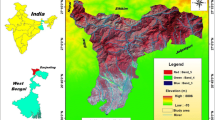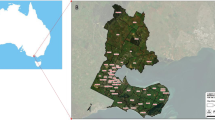Abstract
Land-use allocation is an important way to promote the intensive and economic use of land resources and achieve the goal of sustainable development. It is a complex spatial optimization problem, and heuristic algorithms have been one of the most effective ways to solve it in past studies. However, heuristic algorithms lack the guidance of planning knowledge, which makes land-use patterns usually unreasonable in practice. This research proposes a spatially explicit genetic algorithm (SEGA) that integrates land-use planning knowledge with the genetic algorithm (GA). The SEGA transforms the spatially implicit computation mode of the GA into a spatially explicit optimization style, which helps to promote the effectiveness of regional land-use allocation. Gaoqiao Town, China, was selected as the study area to test the SEGA. Results show that: (1) land-use conversions are reasonable in accordance with planning knowledge, and they improve overall land-use suitability and spatial compactness; (2) compared with the GA, the SEGA is superior in achieving global objectives and simulating local dynamics. We demonstrated that planning knowledge is essential to heuristic algorithms for land-use allocation.





Similar content being viewed by others
References
Aerts JC, Eisinger E, Heuvelink G, Stewart TJ (2003a) Using linear integer programming for multisite land-use allocation. Geogr Anal 35(2):148–169
Aerts JC, van Herwijnen M, Stewart TJ (2003). Using simulated annealing and spatial goal programming for solving a multi site land use allocation problem. Evolutionary multicriterion optimization. In: Fonseca CM, PJ Fleming, Zitzler E, Deb K, and Thiele L. eds, Evolutionary Multi-Criterion Optimization, Lecture Notes in Computer Science. Springer, Berlin
Aguiar APD, Câmara G, Escada MIS (2007) Spatial statistical analysis of land-use determinants in the Brazilian Amazonia: exploring intra-regional heterogeneity. Ecol Model 209(2):169–188
Arentze TA, Borgers AWJ, Ma LD, Timmermans HJP (2010) An agent-based heuristic method for generating land-use plans in urban planning. Environ Plann B Plann Des 37(3):463–482
Bone C, Dragicevic S, White R (2011) Modeling-in-the-middle: bridging the gap between agent-based modeling and multiobjective decision-making for land use change. Int J Geogr Inf Sci 25(5):717–737
Cao K, Huang B, Wang S, Lin H (2012) Sustainable land use optimization using boundary-based fast genetic algorithm. Comput Environ Urban Syst 36(3):257–269
Carsjens GJ, van der Knaap W (2002) Strategic land-use allocation: dealing with spatial relationships and fragmentation of agriculture. Landsc Urban Plan 58(2–4):171–179
Castella J-C, Pheng Kam S, Dinh Quang D, Verburg PH, Thai Hoanh C (2007) Combining top-down and bottom-up modelling approaches of land use/cover change to support public policies: application to sustainable management of natural resources in northern Vietnam. Land use policy 24(3):531–545
Duh J-D, Brown DG (2007) Knowledge-informed Pareto simulated annealing for multiobjective spatial allocation. Comput Environ Urban Syst 31(3):253–281
Eastman JR, Jiang H, Toledano J (1998) Multi-criteria and multiobjective decision making for land allocation using GIS, multicriteria analysis for land-use management. Springer, New York, pp 227–251
Foley JA, DeFries R, Asner GP, Barford C, Bonan G, Carpenter SR, Chapin FS, Coe MT, Daily GC, Gibbs HK (2005) Global consequences of land use. Science 309(5734):570–574
Jones DF, Mirrazavi SK, Tamiz M (2002) Multi-objective meta-heuristics: an overview of the current state-of-the-art. Eur J Oper Res 137(1):1–9
Li X, Gar-On Yeh A (2004) Data mining of cellular automata’s transition rules. Int J Geogr Inf Sci 18(8):723–744
Li X, Liu X (2008) Embedding sustainable development strategies in agent-based models for use as a planning tool. Int J Geogr Inf Sci 22(1):21–45
Ligmann-Zielinska A, Jankowski P (2010) Exploring normative scenarios of land use development decisions with an agent-based simulation laboratory. Comput Environ Urban Syst 34(5):409–423
Liu X, Li X, Tan Z, Chen Y (2011) Zoning farmland protection under spatial constraints by integrating remote sensing, GIS and artificial immune systems. Int J Geogr Inf Sci 25(11):1829–1848
Liu X, Li X, Shi X, Huang K, Liu Y (2012a) A multitype ant colony optimization (MACO) method for optimal land use allocation in large areas. Int J Geogr Inf Sci 26(7):1325–1343
Liu Y, Liu D, Liu Y, He J, Jiao L, Chen Y, Hong X (2012b) Rural land use spatial allocation in the semiarid loess hilly area in China: using a particle swarm optimization model equipped with multiobjective optimization techniques. Sci China Earth Sci 55(7):1166–1177
Liu Y, Wang H, Ji Y, Liu Z, Zhao X (2012c) Land use zoning at the county level based on a multiobjective particle swarm optimization algorithm: a case study from Yicheng, China. Int J Environ Res Public Health 9(8):2801–2826
Liu X, Ou J, Li X, Ai B (2013) Combining system dynamics and hybrid particle swarm optimization for land use allocation. Ecol Model 257:11–24
Masnavi MR (2000) The new millennium and the new urban paradigm: the compact city in practice. In: Williams K, Burton E, Jenks M (eds) Achieving Sustainable Urban Form. E&FN Spon, New York, pp 64–74
Overmars KP, Verburg PH, Veldkamp T (2007) Comparison of a deductive and an inductive approach to specify land suitability in a spatially explicit land use model. Land use policy 24(3):584–599
Santé-Riveira I, Boullón-Magán M, Crecente-Maseda R, Miranda-Barrós D (2008) Algorithm based on simulated annealing for land-use allocation. Comput Geosci 34(3):259–268
Stewart TJ, Janssen R, van Herwijnen M (2004) A genetic algorithm approach to multiobjective land use planning. Comput Oper Res 31(14):2293–2313
Uchida E, Xu J, Rozelle S (2005) Grain for green: cost-effectiveness and sustainability of China’s conservation set-aside program. Land Econ 81(2):247–264
Wang H, Gao Y, Liu Q, Song J (2010) Land use allocation based on interval multi-objective linear programming model: A case study of Pi County in Sichuan Province. Chinese Geogr Sci 20(2):176–183
Yeo IY, Guldmann JM, Gordon SI (2007) A hierarchical optimization approach to watershed land use planning. Water Resour Res 43(11). doi:10.1029/2006WR005315
Yu J, Chen Y, Wu J, Khan S (2011) Cellular automata-based spatial multicriteria land suitability simulation for irrigated agriculture. Int J Geogr Inf Sci 25(1):131–148
Acknowledgments
This work was supported by the Fundamental Research Funds for the Central Universities (grant number 2014205020204); and National Natural Science Foundation of China (grant number 41371429).
Author information
Authors and Affiliations
Corresponding author
Rights and permissions
About this article
Cite this article
Liu, Y., Yuan, M., He, J. et al. Regional land-use allocation with a spatially explicit genetic algorithm. Landscape Ecol Eng 11, 209–219 (2015). https://doi.org/10.1007/s11355-014-0267-6
Received:
Revised:
Accepted:
Published:
Issue Date:
DOI: https://doi.org/10.1007/s11355-014-0267-6




